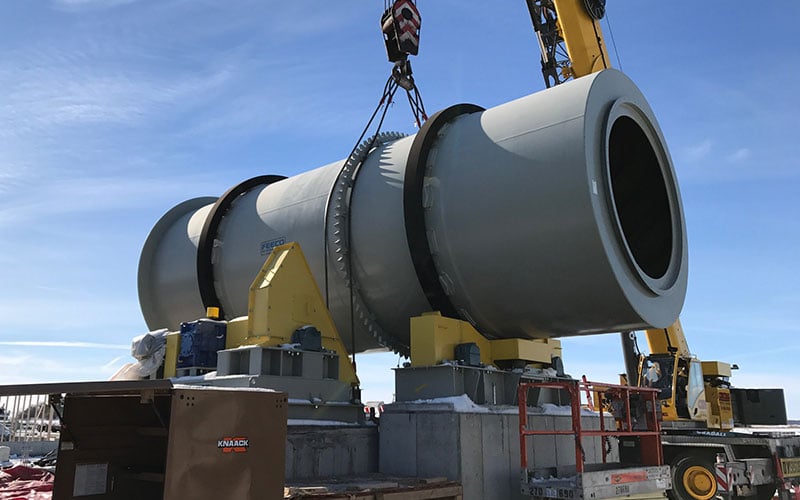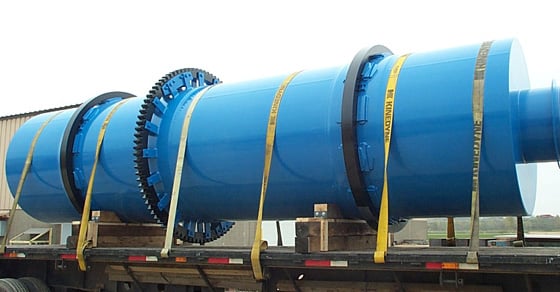The granulation of fertilizer products provides one of the most viable ways to produce granular multi-nutrient fertilizers, improving bulk storage, packaging qualities, as well as promoting ease of handling and application.
To achieve this, fertilizer producers rely on the granulation drum – a device known for its reliable operation and robust build, making it an ideal fit for the fertilizer industry’s broad and ever-changing demands.

Installation of a FEECO Fertilizer Granulation Drum
How the Granulation Drum Produces a Superior Fertilizer Product
The definition of a granule, as it relates to this piece of equipment, is a solid, spherical pellet, in the size range of approximately 1-6 mm. These granules can vary in physical properties and chemical makeup, depending on what is desired for the application.
A granulation drum is frequently used to agglomerate inorganic fertilizers such as NPK; the nitrogen (N), phosphate (P), and potash (K) typically start as a fine powder, which can either be granulated into an all-in-one product known as a complex fertilizer, or granulated separately and blended together later to achieve the desired nutrient formulation. Without granulation, the fine powdery materials would be dusty and difficult to handle; the denser particles would settle to the bottom of the bag or barrel, creating an inconsistent blend (segregation) and causing significant application challenges.
Similarly in the production of diammonium phosphate (DAP) or monoammonium phosphate (MAP), the granulation drum is utilized for a continued chemical reaction in correlation with the formation of a solid granule. The reaction, traditionally initiated in a pre-neutralizer tank, neutralizes the phosphoric acid slurry with ammonia, while simultaneously creating a granule that contains both phosphate and nitrogen.
In addition to developing durable, consistent granules, the granulation drum can also create a more dynamic granular product. Different liquid binders and coatings can be used to create granules with time-release properties, or a multi-layered pellet can be created by adding different minerals at varying stages of the granulation process.
Granulation Drum Design
A rotary granulation drum is relatively simple in design – raw material is fed into a large rotating cylinder, liquid binder is added, and the material tumbles to create solid, spherical pellets, in some cases utilizing a chemical reaction as part of the process. However, extensive design and engineering is needed in order to build a quality piece of equipment capable of creating a consistent product at high capacities.
Several questions must first be addressed before granulation drum design can begin, some of which include:
- Is the material(s) organic or inorganic?
- What is the nutrient content?
- What binders will work the best for the desired time release, while still preventing degradation from storage and shipping?
These, along with many other factors, will affect the overall design of a granulation drum.
After the material questions have been answered, efforts move to the sizing aspects of the drum, which will control the desired output (usually measured in tons per hour {tph}).
Finally, rotational speed and drum slope need to be taken into account. To get a consistent granule, the granulation drum must run at a speed that allows the material to cascade off the side of the drum; too slow and the material will shuffle back and forth at the bottom of the drum; too fast and the material will cling to the drum walls due to centrifugal force.
A perfect balance must be achieved. This balance point, along with other critical process data, is often obtained through research and development at FEECO’s on-site testing facility, The FEECO Innovation Center.
Advances in Granulation Drum Design
Nearly all industries have seen tremendous advancements due to modern technology. Some of the key advancements in granulation drum design include:
Flexible and Corrosion-Resistant Drum Liners: Liners can be used to reduce or eliminate material build-up on the drum walls, as well as decrease the potential for damage caused by corrosive materials.
Tumbler flights: Tumbling flights can be used to increase the material agitation in order to perfect the cascading effect and create the desired granule properties.
Conclusion
The granulation drum has long served as the basis of modern fertilizer production. This versatile piece of equipment has helped bring numerous fertilizer products to the consumer market by creating a durable granule that is easy to handle, package, ship, and apply.
FEECO has been the fertilizer industry’s preferred granulation drum provider since 1951. Our granulation drums are robust and reliable, and manufactured to the highest quality standards. We also offer unmatched feasibility testing and granulation process development services in our test facility, as well as comprehensive parts and service support. For more information on our granulation drums or services, contact us today!


